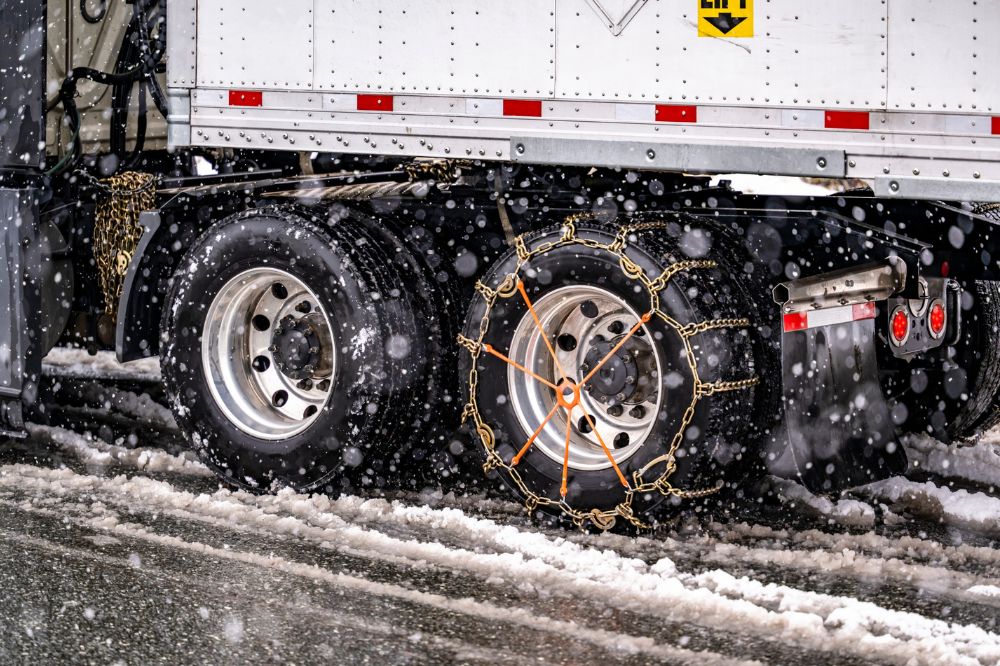
Ice road driving is one of the most specialized areas of trucking. It’s dangerous and requires plenty of knowledge and experience driving in harsh conditions.
If you’ve ever been ice fishing, then you understand just how different it is to drive over frozen bodies of water. Even a small lake can pose a major challenge for a heavily loaded truck.
While ice driving is scary, ice road truckers can also be some of the highest-paid semi-truck drivers. Let’s explore exactly what ice road trucking is and how semi-truck drivers can safely navigate ice roads.
What is Ice Road Driving for Semi Trucks?
Ice road driving is when semi trucks drive on frozen bodies of water, like frozen lakes or rivers, that have turned into solid ice during the winter. These frozen roads are like temporary highways, connecting isolated communities in cold regions of the Northern Hemisphere.
While driving over black ice is challenging enough, true ice road truckers take this even further by covering long distances over entire frozen bodies of water.
Importance of Ice Roads in Certain Regions
Ice roads are crucial in certain regions because they provide the only means for transporting goods and supplies to isolated communities during the winter months.
These frozen highways, built on thick ice over lakes and rivers, connect remote areas that are otherwise cut off from the rest of the world.

Ice Thickness Requirements
The most important requirement for ice driving is having the right ice thickness for semi trucks.
The minimum ice thickness required to support heavy vehicles is typically around 30 inches. This is for a 70-ton vehicle. You only need 3 inches of ice to support a single person, and a very light truck could navigate 8-inch ice. Of course, thicker ice is best if you’re driving a large or medium truck.
However, this can vary based on factors like air temperature, pressure, and other variables that influence the strength of the ice. Colder temperatures and higher pressures make the ice stronger.
To determine how thick the ice is, you’ll need to use methods like drilling, using an ice auger, or even using ice radar and sonar.
The Dangers of Ice Road Driving
Driving over lake ice in a semi-truck, or even a small truck, comes with plenty of dangers. Here’s what you need to be aware of.
Slippery Surfaces
Driving on ice is a challenge due to the slippery surface. Even with studded tires and chains, traction is limited.
Trucks can easily lose control, so drivers need to be extra cautious, maintaining slow and steady speeds to reduce the risk of skidding or sliding.
Limited Visibility
Snow and ice can severely reduce visibility on ice roads. Blowing snow, fog, and blizzards makes it hard for drivers to see the road ahead.
Unpredictable Conditions
Weather and road conditions on ice roads can change suddenly and without warning. Sudden blizzards, strong winds, and shifting ice can make driving extremely dangerous.
This is why it’s vital to constantly monitor weather forecasts and road reports, and consult local authorities on the weather to avoid getting caught in dangerous situations.
Increased Braking Distance
Braking on ice roads is much more difficult due to decreased friction. Ice increases the braking distance significantly, making it harder for trucks to stop quickly.

Driver Isolation – Slow Speeds, Long Trips
Ice road driving is all about slow speeds and long trips, which leads to driver isolation. The remote locations and the long, monotonous stretches of road can be mentally challenging.
Drivers must be prepared for the isolation, ensuring they have enough supplies, including food, water, and emergency equipment, to stay safe during the journey.
Why Ice Roads are Necessary
Ice road trucking might seem crazy, but it’s an important job in many isolated regions. Here’s why.
Remote Access to Far Off Places
Ice roads provide vital transportation links to isolated communities.
In remote regions, where regular roads are impractical or impossible to build, ice roads offer a lifeline. They ensure that isolated communities have access to necessary resources during the winter months.
Economic Benefits
Ice roads allow for resources to be moved and economic development to continue throughout winter in remote regions.
Environmental Considerations
Compared to alternative transport routes, ice road driving has a much smaller environmental impact.
Constructing permanent roads can be seriously environmentally damaging. Ice roads, however, are temporary. They require no land clearing or construction.
Safety Precautions for Ice Road Driving
Moving water, cracks, and melting ice are some of the biggest safety concerns for ice road truck driving. Here are some essential tactics to help you stay safe.
Check the Ice Thickness
Before driving on an ice road, always check the ice conditions and thickness. Ensure it meets safety standards and is thick enough to support the weight of your vehicle.
Reduce Your Speed
Maintain slow and steady speeds to reduce the risk of skidding on ice or sliding through snow cover.
Even with studded tires and chains, traction is limited. Applying defensive driving techniques is always good practice.

Know the Route
Familiarize yourself with the ice road route before starting your journey. Be aware of any potential hazards, such as areas with thin ice, and carefully plan your journey.
Safety Equipment
Make sure your truck is equipped with all the right gear. This includes things like strong fog lights, reflective markers, tire chains, and suitable ice-driving tires. You’ll also need an ice pick or ice chisel, an auger, and a tape measure to check ice thickness.
Equip your truck with safety essentials like emergency flares, a first aid kit, a fire extinguisher, a life jacket, and a survival kit in case of an emergency. Of course, a proper semi-truck tool kit is also a necessity.
Regular Maintenance
Keep your vehicle well-maintained, including checking tire pressure, ensuring all lights are working, and the brakes are in good condition.
Final Thoughts
Even on thick ice, navigating these routes with the weight of a semi-truck is an enormous challenge. This is why it’s crucial for ice road drivers to be properly prepared and experienced in navigating icy routes.
Of course, ice road driving can only be done with the right, reliable vehicle. Get in touch with us at Mission Financial Services if you’re looking for the best solution for financing a new semi-truck.


